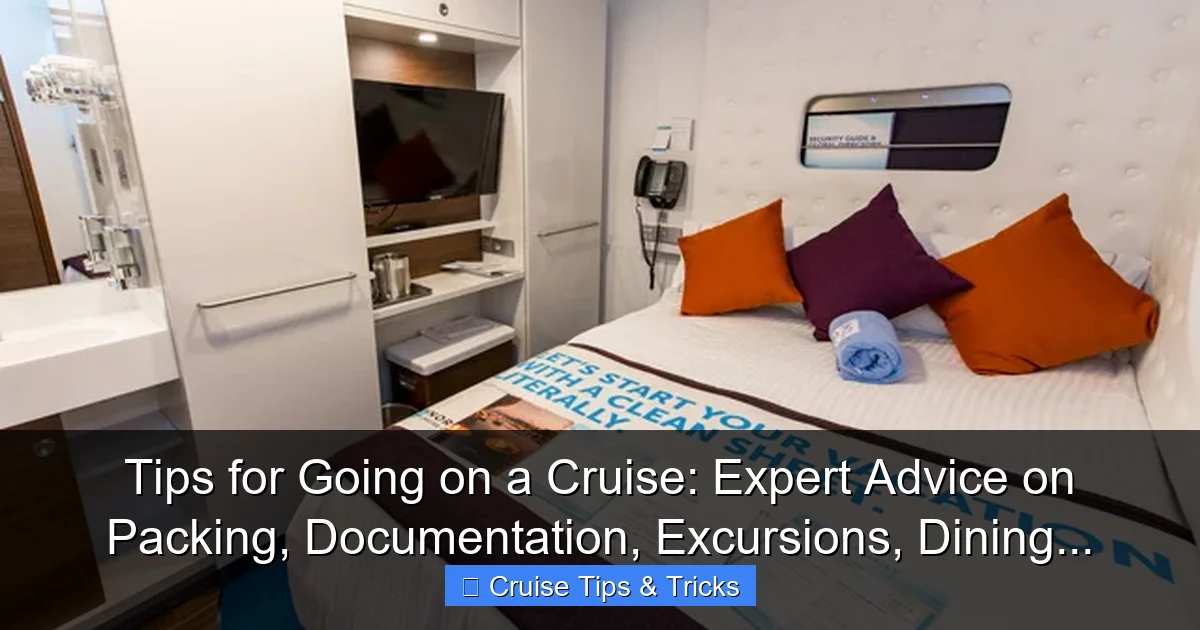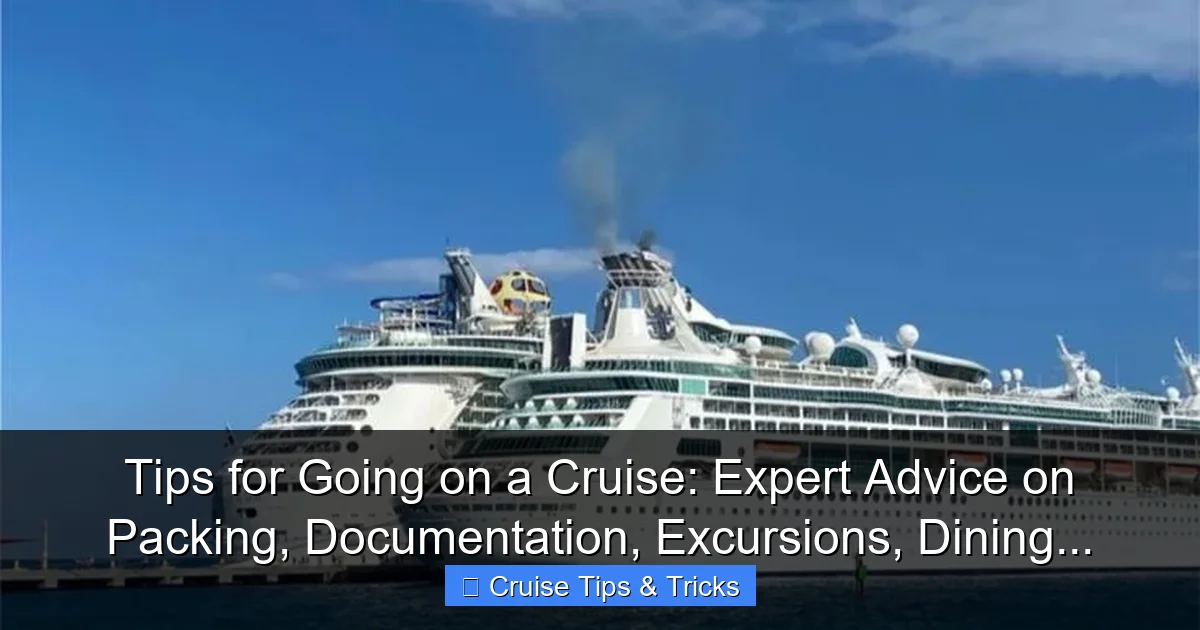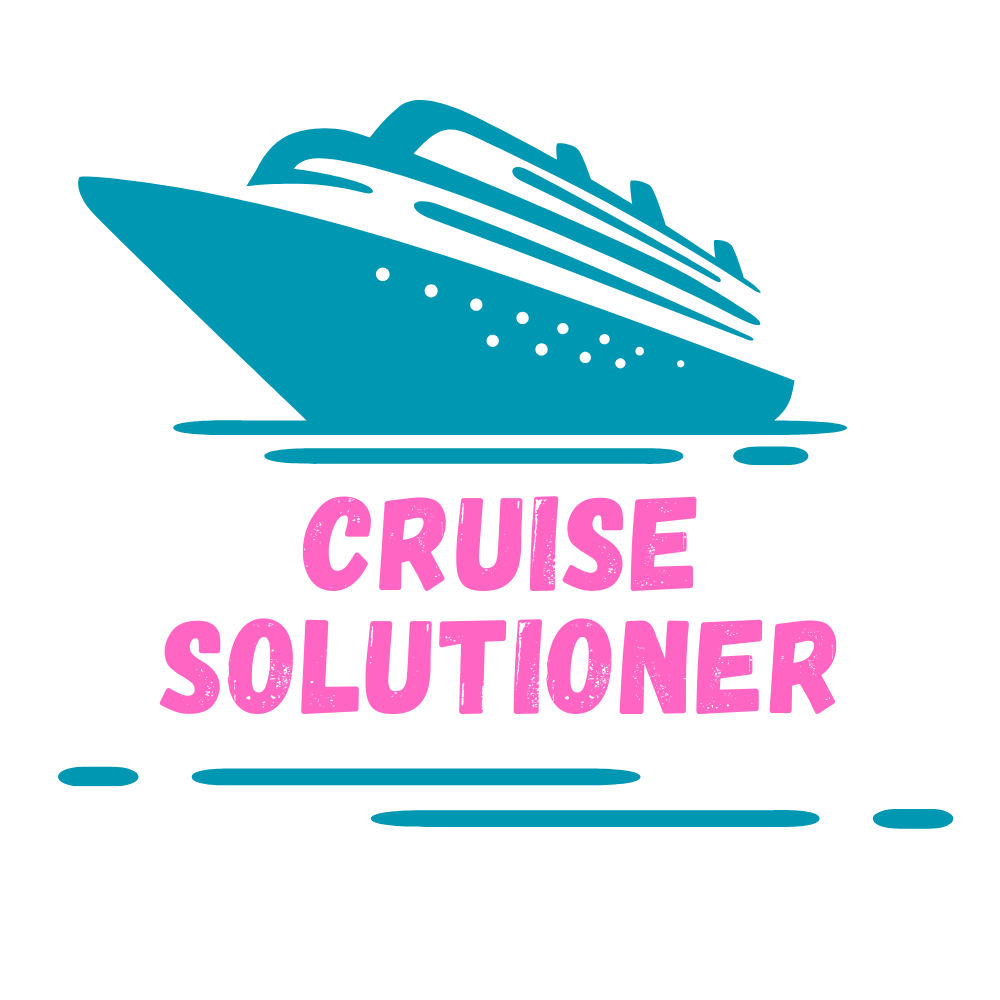
Featured image for this comprehensive guide about tips for going on a cruise
Image source: i.pinimg.com
Ah, the allure of the open sea! Imagine waking up to a new horizon each day, indulging in gourmet meals, exploring vibrant cultures, and soaking up endless sunshine. For many, a cruise vacation represents the ultimate escape – a floating resort that takes you to breathtaking destinations without the hassle of constant packing and unpacking. Whether you’re a seasoned seafarer or dreaming of your very first voyage, the anticipation of **going on a cruise** is truly special.
However, turning that dream into a seamless reality requires a bit of savvy planning. From deciphering the best cabin choice to understanding port day logistics, there’s a treasure trove of information that can transform a good cruise into an unforgettable one. That’s precisely why we’ve compiled this comprehensive guide: to equip you with expert **cruise tips** and actionable advice for every stage of your journey.
Get ready to embark on an adventure of preparation as we dive deep into everything you need to know. We’ll cover essential documentation, smart packing strategies, how to maximize your onboard experience, navigating shore excursions, staying healthy and safe, and managing your budget. Consider this your ultimate resource for ensuring your next (or first!) **cruise vacation** is nothing short of spectacular. Let’s set sail!
Quick Answers to Common Questions
What are some essential packing tips for going on a cruise?
Pack versatile clothing for both warm and cool weather, including swimsuits, formal wear for specialty dining, and comfortable shoes for excursions. Don’t forget essentials like sunscreen, hats, and any necessary medications – these are crucial tips for going on a cruise!
Do I need a passport as part of my documentation tips for going on a cruise?
For most international cruises, yes, a valid passport is essential. Always double-check your specific cruise line’s requirements and destination country rules well in advance of your sailing date.
How do I manage dining and food options on the ship?
Most cruises include fantastic main dining rooms and buffet options, but specialty restaurants often come with an extra charge. It’s smart to make reservations for specialty dining online before you sail, which is one of the best tips for going on a cruise to secure your preferred times.
What should I know about booking shore excursions?
You can book excursions directly through the cruise line or independently from local providers. Booking through the cruise line often offers convenience and guaranteed return to the ship, which can be a valuable tip for going on a cruise, especially for first-timers.
What’s a top tip for going on a cruise for a first-timer to ensure a smooth trip?
Download your cruise line’s app before you board! It’s an invaluable tool for checking daily schedules, making reservations, finding your way around, and even communicating with travel companions, helping you maximize your fun.
📋 Table of Contents
- Before You Sail: Pre-Cruise Planning & Preparation
- Packing Smart: What to Bring (and What to Leave Behind)
- Onboard Experience: Maximizing Your Time at Sea
- Shore Excursions: Making the Most of Port Days
- Staying Healthy & Safe: A Priority for Every Cruiser
- Budgeting & Tipping: Navigating the Financial Waters
- Conclusion: Your Unforgettable Cruise Awaits!
Before You Sail: Pre-Cruise Planning & Preparation
The success of your **cruise trip** often hinges on the groundwork you lay before you even step foot on the ship. Diligent pre-cruise planning can save you stress, money, and ensure a smoother embarkation. These **first-time cruise tips** are especially vital.

Learn more about tips for going on a cruise – Tips for Going on a Cruise: Expert Advice on Packing, Documentation, Excursions, Dining…
Image source: oyster.com
Booking Your Dream Cruise
- Choose the Right Cruise Line & Ship: Research different cruise lines to find one that aligns with your travel style and budget. Some cater to families (Disney, Royal Caribbean), others to luxury (Regent Seven Seas, Silversea), adventure (Norwegian), or a more relaxed, adult-oriented experience (Viking, Celebrity). Consider the ship’s size, amenities, and typical passenger demographic.
- Select Your Itinerary & Season: Where do you want to go? Alaska, Caribbean, Mediterranean, Europe? Research the best time of year to visit your chosen destination. For example, hurricane season in the Caribbean runs from June to November, while Alaska cruises are typically May to September. Off-peak seasons often offer better deals but may have different weather or fewer options.
- Cabin Selection: Your cabin choice significantly impacts your experience and budget.
- Inside Cabins: Most economical, no window. Great for those on a budget or who spend little time in their cabin.
- Ocean View Cabins: A window or porthole to the outside, but it doesn’t open.
- Balcony Cabins: A private veranda to enjoy the views and fresh air. Highly recommended for scenic itineraries or if you value personal outdoor space.
- Suites: Larger, often with extra amenities, butler service, and exclusive access to certain areas.
Consider location too – mid-ship and lower decks are generally best for those prone to motion sickness.
- Book in Advance (or Last Minute): For popular itineraries or specific cabin types, booking 6-12 months out often yields the best rates and choices. However, if you’re flexible, last-minute deals can pop up closer to sailing.
Essential Documentation & Travel Insurance
This is arguably the most critical aspect of your **cruise planning**. Without the correct documents, you won’t be allowed to board.
| Cruise Aspect | Recommendation | Key Benefit / Consideration |
|---|---|---|
| Booking Strategy | Book 6-12 Months Ahead | Secure best rates (often 10-25% savings) and widest cabin selection. Last-minute deals are rare for popular sailings. |
| Cabin Choice | Consider an Inside Cabin | Most budget-friendly option, typically 30-50% less than balcony cabins. Ideal for sleeping and saving money for excursions. |
| Drink Packages | Evaluate Your Consumption | Cost-effective if you plan to consume 5-7+ alcoholic drinks per day. Otherwise, à la carte or a non-alcoholic package might save you 15-25%. |
| Shore Excursions | Research Independent Options | Can save 20-40% compared to cruise line excursions. Be mindful of return times to avoid missing the ship. |
| Internet Access | Limit Onboard Wi-Fi Use | Onboard Wi-Fi packages typically range from $15-$30/day and can be slow. Utilize port Wi-Fi or disconnect and enjoy the cruise. |
- Passport: For most international cruises, a valid passport is essential. Ensure it’s valid for at least six months beyond your return date. Even for “closed-loop” cruises (starting and ending in the same U.S. port), while a birth certificate and government-issued ID *might* be accepted, a passport is always the safest and most recommended option, especially in emergencies.
- Visas: Research if any of your port stops require a visa for your nationality. Your cruise line will often provide guidance on this, but it’s ultimately your responsibility.
- Cruise Documents: Have your booking confirmation, boarding passes (often electronic), luggage tags (print these at home if provided), and any other cruise line-specific paperwork ready.
- Travel Insurance: This is a non-negotiable **cruise tip**. While cruise lines offer their own insurance, independent travel insurance often provides broader coverage for trip cancellation/interruption, medical emergencies (which can be incredibly expensive overseas), lost luggage, and emergency evacuation. Around 30% of cruisers experience some form of travel disruption, making insurance a wise investment.
- Health Information: Pack copies of prescriptions, physician contact information, and medical alerts. Check any current health advisories for your destination.
Packing Smart: What to Bring (and What to Leave Behind)
**Cruise packing** is an art form. You want to be prepared for every occasion without overpacking. Remember, cabin space is limited!

Learn more about tips for going on a cruise – Tips for Going on a Cruise: Expert Advice on Packing, Documentation, Excursions, Dining…
Image source: i.pinimg.com
Clothing & Accessories
- Mix & Match Wardrobe: Pack versatile pieces that can be dressed up or down. Think layers for varying temperatures.
- Daytime Attire: Shorts, t-shirts, sundresses, swimwear. Include comfortable walking shoes for excursions.
- Evening Wear: Most cruise lines have a flexible dress code.
- Casual: Jeans, shorts, t-shirts are generally fine for casual dining venues.
- Smart Casual: Collared shirts, slacks, skirts, blouses, casual dresses for main dining rooms.
- Formal (Optional): Some ships have “formal nights” where suits, tuxedos, cocktail dresses, or gowns are encouraged but usually not mandatory. Check your cruise line’s specific guidelines if you wish to participate.
- Specialty Items:
- Swimsuits: Pack at least two so one can dry.
- Cover-ups: For walking around the ship from the pool.
- Workout Gear: If you plan to use the gym.
- Theme Night Outfits: Some cruises have ’80s nights, white parties, etc.
- Rain Gear: A lightweight rain jacket or umbrella can be a lifesaver.
- Sun Protection: Hat, sunglasses, reef-safe sunscreen.
Health, Hygiene & Essentials
- Medications: Bring more than enough prescription medications in their original containers, plus any over-the-counter essentials (pain relievers, antacids, seasickness remedies like Dramamine or motion sickness patches).
- Toiletries: While ships provide basics, bring your preferred brands, especially for hair care and skincare.
- First-Aid Kit: Small one with band-aids, antiseptic wipes, pain relievers, allergy meds.
- Power Strip/USB Hub: Cabins often have limited outlets. Ensure it’s surge-protector-free, as many cruise lines prohibit these for safety. A USB charging hub is usually fine.
- Refillable Water Bottle: Stay hydrated and reduce plastic waste.
- Small Backpack/Daypack: Invaluable for shore excursions to carry water, sunscreen, camera, and souvenirs.
- Magnetic Hooks: Cabin walls are often metal, so these are great for hanging clothes, hats, or bags, maximizing space.
- Waterproof Phone Pouch: Protects your phone during water activities or unexpected splashes.
- Laundry Bag: Keep dirty clothes separate.
What NOT to Pack
- Prohibited Items: Irons, clothing steamers, candles, illegal drugs, weapons, anything with an open flame. Check your cruise line’s specific list.
- Excessive Valuables: Leave expensive jewelry at home. While cabins have safes, it’s better to be safe than sorry.
- Too Many Shoes: They take up a lot of space. Limit yourself to 3-4 versatile pairs (walking, dressy, sandals).
Cruise Packing Checklist Essentials
| Category | Item | Notes |
|---|---|---|
| Documents | Passport/ID | Valid for 6+ months post-trip |
| Cruise Docs/Tickets | Printed & digital copies | |
| Travel Insurance Info | Emergency contacts & policy # | |
| Clothing | Swimsuits (x2) | One to wear, one to dry |
| Casual Daywear | Shorts, t-shirts, sundresses | |
| Smart Casual Evening Wear | Slacks, blouses, collared shirts | |
| Light Jacket/Cardigan | For air conditioning or cool evenings | |
| Comfortable Walking Shoes | Essential for port days | |
| Health & Toiletries | Prescription Meds | In original bottles, enough for trip + extra |
| Motion Sickness Relief | Dramamine, patches, ginger chews | |
| Sunscreen (Reef-Safe) | High SPF, environmentally friendly | |
| Basic First-Aid Kit | Band-aids, pain relievers, antiseptic | |
| Personal Toiletries | Shampoo, conditioner, soap, etc. | |
| Miscellaneous | Portable Power Bank | For charging devices on the go |
| Refillable Water Bottle | Stay hydrated and eco-friendly | |
| Small Daypack/Backpack | For shore excursions | |
| Magnetic Hooks | To maximize cabin space | |
| Waterproof Phone Pouch | For pool or beach activities |
Onboard Experience: Maximizing Your Time at Sea
Once you’re on the ship, the real fun begins! With so many options available, these **cruise ship tips** will help you make the most of your time.
Dining & Drinks
- Explore All Dining Options: Beyond the main dining room and buffet, most ships offer specialty restaurants (often for an extra fee) and casual venues like pizzerias or cafes. Try a variety!
- Book Specialty Dining Early: If there’s a particular restaurant you want to try, make reservations as soon as you board, or even before your cruise if your line allows. They fill up fast.
- Drink Packages: Consider if a drink package is worth it for you. Do the math based on how many alcoholic beverages, specialty coffees, or sodas you typically consume daily. They can be good value for some, a waste for others.
- Room Service: Many ships offer complimentary 24-hour room service, perfect for a quiet breakfast or late-night snack.
- Dietary Restrictions: Notify your cruise line well in advance if you have any dietary needs (allergies, vegetarian, gluten-free). They are usually excellent at accommodating.
Entertainment & Activities
- Read the Daily Program: Your ship will deliver a daily newsletter (or have an app) outlining all activities, shows, and dining hours. Plan your day around what interests you.
- Attend Shows & Events: From Broadway-style productions to live music, comedy acts, and game shows, there’s always something happening. Arrive early for popular shows to get a good seat.
- Utilize Onboard Amenities: Enjoy the pools, hot tubs, fitness center, spa, casino, and sports courts. Many ships also have unique features like rock climbing walls, surf simulators, or go-kart tracks.
- Spa Treatments: Book spa services early, especially if you want a specific time slot or if you’re interested in embarkation/port day specials (which are often discounted).
- Kids’ Clubs: If traveling with children, enroll them in the kids’ club. It provides supervised fun for them and free time for adults.
Internet & Communication
- Wi-Fi Packages: Onboard Wi-Fi can be expensive. Purchase a package if you need to stay connected, but consider a “digital detox” to fully enjoy your **cruise vacation**. Many ships offer different tiers, from basic messaging to full streaming.
- “Free” Wi-Fi in Port: In many ports, you can find free Wi-Fi at cafes or restaurants. This is a great way to check in without breaking the bank.
- Airplane Mode: Keep your phone in airplane mode while at sea to avoid exorbitant roaming charges from your cell provider.
Shore Excursions: Making the Most of Port Days
Port days are your chance to explore incredible destinations. Smart planning here is key to a fulfilling experience.
Booking Excursions
- Cruise Line vs. Independent Operators:
- Cruise Line Excursions: Offer convenience, guaranteed return to the ship (the “ship won’t leave without you” promise), and vetted operators. Often more expensive.
- Independent Operators: Can be more affordable, offer smaller group experiences, and more unique itineraries. Requires more research and self-reliance. If booking independently, ensure you leave plenty of time to get back to the ship before all-aboard time.
- Book in Advance: For popular excursions, especially those offered by the cruise line, book online before your cruise to secure your spot.
- Research Port Destinations: Look up what each port offers. Are there historical sites, beaches, adventure activities, or cultural experiences? Prioritize what appeals most to you.
Port Day Logistics & Safety
- Tender Ports: Some ports require a tender boat (small boat) to shuttle passengers from the ship to shore. This can add significant time to your day, so plan accordingly. Get a tender ticket early if offered.
- Stay Hydrated & Sun-Safe: Especially in warm climates, bring water, wear a hat, sunglasses, and apply sunscreen liberally.
- Local Currency: While credit cards are widely accepted, it’s wise to carry a small amount of local currency for small purchases, tips, or in case of card reader issues. Inform your bank of your travel dates to avoid card freezes.
- Safety in Port: Be aware of your surroundings, keep valuables secure, and avoid walking alone at night in unfamiliar areas. Research local customs and dress codes.
- Know All-Aboard Time: This is crucial. Always be back on the ship well before the published “all-aboard” time to avoid being left behind. The ship’s clock is the only one that matters!
Staying Healthy & Safe: A Priority for Every Cruiser
Your well-being is paramount on any trip. These **cruise safety tips** and health guidelines will help ensure a worry-free journey.
Health & Wellness at Sea
- Hand Hygiene: Wash your hands frequently with soap and water, and use hand sanitizer, especially before and after meals. Norovirus and other germs can spread quickly on cruise ships. This is one of the most emphasized **health tips for cruising**.
- Motion Sickness: If you’re prone to seasickness, pack remedies like Dramamine, Bonine, or ginger chews. Choose a mid-ship cabin on a lower deck, look at the horizon, and try acupuncture bands. Over 25% of cruisers experience some form of motion sickness, so being prepared is wise.
- Stay Hydrated: Drink plenty of water throughout the day, especially in warm climates or if you’re consuming alcohol.
- Ship’s Medical Center: Ships have onboard medical facilities and doctors, but they can be expensive, and insurance often doesn’t cover them entirely. For minor issues, your own first-aid kit might suffice, but for serious concerns, seek professional help.
- Sun Protection: The sun’s reflection off the water can intensify its rays. Use high SPF sunscreen, reapply often, and seek shade.
Safety & Security Onboard
- Familiarize Yourself with the Ship: On embarkation day, find your muster station (for emergency drills), exit routes, and key locations like dining rooms and medical center.
- Cabin Safe: Utilize the safe in your cabin for passports, cash, and other valuables.
- Be Aware of Your Surroundings: While cruise ships are generally safe, always exercise caution. Don’t leave drinks unattended and report any suspicious activity.
- Emergency Drills: Pay attention during the mandatory safety drill. It’s for your safety.
- Responsible Alcohol Consumption: Enjoy alcoholic beverages in moderation. Over-consumption can lead to impaired judgment and increased risk.
Budgeting & Tipping: Navigating the Financial Waters
Understanding cruise costs beyond the initial fare is crucial for a stress-free trip. These **cruise budgeting tips** will help you avoid unwelcome surprises.
Understanding Cruise Costs
- What’s Included vs. Extra: The base fare typically includes your cabin, most meals (main dining room, buffet), basic entertainment, and access to pools/gym.
- Common Extras: Specialty restaurants, alcoholic beverages, soda packages, bottled water, shore excursions, spa treatments, Wi-Fi, casino, gift shop purchases, certain fitness classes, and gratuities.
- Hidden Fees: Port taxes and fees are usually added to the base fare and can be substantial. Check the total price before booking.
- Set a Daily Budget: Once you account for included items, estimate your daily spending for extras like drinks, souvenirs, and activities.
- Pre-Pay Where Possible: Many cruise lines allow you to pre-pay gratuities, drink packages, and even some excursions online before you sail. This helps spread out the cost and reduces the “bill shock” at the end of your cruise.
Tipping Etiquette
Gratuities are a significant part of the cruise experience and are essential for the hardworking crew members. There are generally two ways to handle them:
- Automatic Gratuities: Most cruise lines automatically add a daily service charge per person to your onboard account. This is distributed among the dining staff, cabin stewards, and other service personnel. You can usually adjust this amount at guest services if you feel the service warrants it (though this is rare).
- Discretionary Tipping: For exceptional service, you might want to give additional cash tips to specific individuals, such as your favorite bartender, a concierge, or an outstanding shore excursion guide. Spa services often have a 15-18% service charge automatically added.
Typical Daily Gratuity Guidelines (Per Person)
(Note: These are general averages and can vary by cruise line and cabin type. Always check your specific cruise line’s policy.)
| Cruise Line Type | Standard Cabins (per day) | Suites (per day) |
|---|---|---|
| Mainstream (e.g., Carnival, Royal Caribbean, Norwegian) | $16.00 – $18.00 | $20.00 – $25.00 |
| Premium (e.g., Celebrity, Holland America, Princess) | $17.00 – $19.00 | $21.00 – $25.00 |
| Luxury (e.g., Oceania, Viking Ocean, Azamara) | Often included in fare, or $18.00 – $22.00 | Often included in fare, or $23.00 – $28.00 |
Onboard Account Management
- Credit Card Registration: Upon embarkation, you’ll link a credit card to your onboard account for all purchases. Some lines allow cash deposits.
- Monitor Your Spending: Most ships allow you to check your onboard account balance via your cabin TV or a mobile app. Keep an eye on it to avoid surprises.
Conclusion: Your Unforgettable Cruise Awaits!
Embarking on a cruise is an extraordinary way to see the world, offering a unique blend of adventure, relaxation, and discovery. By following these **tips for going on a cruise**, you’re not just booking a vacation; you’re investing in a smooth, enjoyable, and truly unforgettable experience. From meticulously preparing your documents and packing intelligently to maximizing your onboard activities and navigating port days like a pro, every piece of advice in this guide is designed to empower you.
Remember, the goal is to relax, explore, and create lasting memories. Don’t get bogged down in every tiny detail, but do take the time to understand the essentials. With careful planning and a spirit of adventure, your **cruise vacation** promises to be everything you’ve dreamed of and more. So, what are you waiting for? Start planning your next great escape – the ocean is calling!
🎥 Related Video: 5 Tips For First Time Cruisers 🛳️
📺 Kemoy Martin
Frequently Asked Questions
What are the essential items to pack for a cruise, and what should I leave at home?
For a cruise, focus on versatile clothing like layers, swimwear, comfortable walking shoes for excursions, and potentially semi-formal attire for evening dining. Remember to pack essentials like sunscreen, medications, and chargers. Crucially, leave prohibited items like irons, candles, or surge protectors at home, as they are fire hazards and not allowed onboard.
What travel documents are necessary for a cruise, especially for international itineraries?
For most international cruises, a valid passport with at least six months of validity beyond your return date is essential. Additionally, ensure you have your cruise line’s boarding pass, any necessary visas for specific ports of call, and copies of important documents stored separately from the originals. Always check the specific requirements for your itinerary and nationality well in advance.
Should I book shore excursions directly through the cruise line or independently?
Booking shore excursions through the cruise line offers peace of mind, as the ship will wait for you if an excursion runs late, and transportation is typically well-organized. Independent booking can often provide more unique experiences, smaller groups, and potentially lower prices, but you bear the responsibility of returning to the ship on time for sailing.
What are the typical dining options available on a cruise ship, and are drinks usually included?
Most cruise ships offer a variety of dining options included in your fare, such as a main dining room with rotational seating, a casual buffet, and sometimes specialty cafes or grills. While basic beverages like water, tea, coffee, and some juices are typically included, sodas, alcoholic drinks, and premium coffees usually incur extra charges or require purchasing a drink package. Specialty restaurants are also available for an additional fee.
How does payment work on a cruise ship, and do I need to carry cash?
Cruise ships typically operate on a cashless system, where all onboard purchases are charged to your room key card, which is linked to your credit card or a cash deposit made at check-in. While you won’t need cash for most onboard transactions, it’s wise to carry small bills for tipping porters at the pier, taxi drivers, tour guides, or for making small purchases in ports of call.
What’s one crucial tip for first-time cruisers to ensure a smooth and enjoyable voyage?
One crucial tip for first-time cruisers is to arrive at your departure port at least a day before your cruise sets sail. This eliminates stress caused by potential travel delays, ensures you don’t miss the ship, and allows you to start your vacation feeling relaxed and refreshed. It also provides an opportunity to explore the embarkation city.
